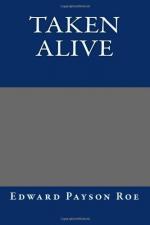It so happens in my experience that I have discovered one who appears willing to stick closer to me than a brother, and even to pass as my “double,” or else he is so helplessly in the hands of his publishers as to be an object of pity. A certain “Edward R. Roe” is also an author, and is suffering cruelly in reputation because his publishers so manage that he is identified with me. By strange coincidence, they hit upon a cover for his book which is almost a facsimile of the cover of my pamphlet novel, “An Original Belle,” previously issued. The R in the name of this unfortunate man has been furnished with such a diminutive tail that it passes for a P, and even my friends supposed that the book, offered everywhere for sale, was mine. In many instances I have asked at news stands, “Whose book is that?” The prompt and invariable answer has been, “E. P. Roe’s.” I have seen book notices in which the volume was ascribed to me in anything but flattering terms. A distinguished judge, in a carefully written opinion, is so uncharitable as to characterize the coincidence in cover as a “fraud,” and to say, “No one can look at the covers of the two publications and fail to see evidence of a design to deceive the public and to infringe upon the rights of the publisher and author”—that is, the rights of Messrs. Dodd, Mead would be well, as a rule, for other writers to begin with reputable, honorable publishers and to remain with them. A publisher can do more and better with a line of books than with isolated volumes. When an author’s books are scattered, there is not sufficient inducement for any one to push them strongly, nor, as in the case above related, to protect a writer against a “double,”




